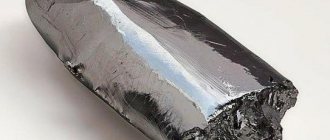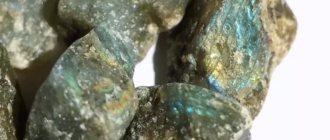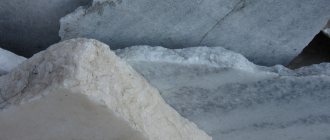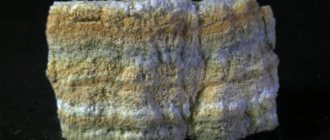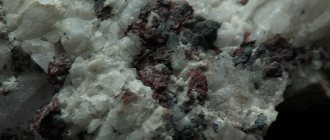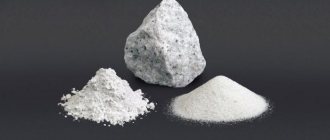Oil shale is a mineral from the group of solid caustobiolites, which during dry distillation produces a significant amount of resin (close in composition to oil). Shales were mainly formed 450 million years ago on the seabed from plant and animal remains. When burned, oil shale releases heat, and during thermal decomposition, shale oil (this product is an analogue of heavy oil and is used as fuel instead of fuel oil), combustible gases and tar water. Both processes are accompanied by the formation of ash.
Oil shale:
Oil shale is a mineral , a solid combustible sedimentary rock, a type of fossil fuel, consisting of organic and mineral parts.
Oil shale is a sedimentary rock with a layered (lamellar) structure in gray, dark gray, black, brown, yellow and olive colors. Easily breaks down into individual tiles and layers.
The mineral part is represented by sedimentary rock, and the organic part is represented by kerogen . Kerogen is a form of unconventional oil. Outwardly, it resembles resin. When oil shale is heated, kerogen releases oil, called "shale oil" or "kerogen oil", and natural gas, called " shale gas ".
Oil shale ignites with a match and, when burned, emits the smell of burnt rubber and smokes heavily. Only organic substances ignite and burn in it.
Oil shale occurs at a depth of 80-200 meters.
According to geologists, oil shale reserves are an order of magnitude greater than conventional oil. However, shale deposits do not play a leading economic role. It refers to alternative sources of heat and chemical raw materials.
Application in the national economy
The use of oil shale as a fuel is ineffective: little heat is generated, but an excessive amount of soot is generated. It makes much more sense to obtain fuel from them in the form of oils and resins.
The Baltic countries actively use shale fuel to produce electricity at their power plants, and the USA and Canada have widely developed the production of shale gas and oil.
In addition, gasoline, household gas, and a number of chemical industry substances are obtained from this class of minerals. Aromatic hydrocarbons, benzene, coke, glue, plastics, synthetic tanning agents, herbicides, bitumen and even medicines are based on substances derived from oil shale. Shale resin provides excellent protection against corrosion, has good insulating properties, provides a reliable connection of materials, and is also used as a chemical soil fertilizer.
Oil shale deposits:
The main resources are concentrated in the USA (Colorado, Utah, Wyoming) and are associated with the Green River formation. Large basins are found in Brazil (Irati, Paraiba), China (Fushun), Russia (Baltic, Volzhsky, Vychegda, Timan-Pechora, Syrdarya, Amudarya basins, Kenderlyk and Bazhenov fields). Numerous oil shale deposits have been found in Bulgaria, Great Britain, Germany, France, Spain, Austria, Canada, Australia, Italy, Sweden, Kazakhstan, Ukraine, and Yugoslavia.
World reserves
Although, according to experts, world reserves of this type of fuel are estimated at 650 trillion. tons, from which it is expected to extract 26 trillion. tons of shale oil, which is an order of magnitude greater than the reserves of conventional oil, the production of such an expensive type of energy raw material is unprofitable.
70% of this wealth is concentrated in Wyoming, Colorado and Utah - US states.
The leaders in shale oil reserves are:
- Russia – 10.23 billion tons.
- USA – 7.911 billion tons.
- China – 4.365 billion tons.
According to shale gas reserves, the places are distributed as follows:
- China – 31.55 trillion. m3.
- Argentina – 22.7 trillion. m3.
- Algeria – 20.0 trillion. m3.
Chemical composition of oil shale:
The composition of the sedimentary rock includes the following minerals : calcite, dolomite, hydromicas, montmorillonite, kaolinite, feldspars, quartz, pyrite and others.
The organic part consists of kerogen. Kerogen is a mixture of organic materials (petrolenes, bitumen, humic substances, etc.). Its composition varies from deposit to deposit. It cannot be described by any single chemical formula. In any case, it contains hydrocarbons and impurities: hydrogen sulfide, nitrogen, etc.
In ordinary oil shale, the proportion of kerogen is 10-30% by weight. And only in the highest quality shale does it reach 50-70%. The rest is sedimentary rock.
The presence of a hydrocarbon component in shale allows it to be extracted. This produces oil and natural gas. However, their extraction is not always economically and environmentally justified.
Extraction methods
Shales are mined in two ways:
- Open (career)
- Underground
Quarrying produces rock that is close to the earth's surface. This method is the least harmful to the environment and nature in general.
The underground mining method is the most expensive and involves the use of special equipment, drilling wells, and the involvement of qualified labor. This extraction method is more efficient, but less environmentally friendly, so it is used far from populated areas and bodies of water.
The disastrous consequences of this method of extraction are:
- soil and air pollution from harmful substances used for hydraulic fracturing;
- soil subsidence in areas where fossil raw materials are mined;
- destructive processes occur in the soil and soil;
- groundwater is polluted.
The compounds formed after hydraulic fracturing are also destructive. In such places there is a marked increase in flora and fauna. “Boiling” streams appear due to methane gas. Poisoning and an increase in cancer among people living near drilling rigs have been noted.
Healing and magical properties of the stone
Supporters of traditional medicine claim that black slate has a positive effect on the functioning of the human body. Dwellings made from this material become a real temple for people: the stone relieves nervous tension, eliminates nightmares, and restores the energy background.
Healers and light magicians connect gray slate with the Cosmos. The mineral receives signals from the Universe, processes them and transmits them to its owner. The stone helps to interpret dreams and opens the talent to see the future. To set up a mineral to work, the owner needs to spend a lot of time with it, mentally ask it questions and thank it for its help. Clay shale has particular power during the full moon and church holidays. Mica also has magical properties. She is able to attract wealth and treat serious illnesses.
Slate stone has a beneficial effect on people whose professional activities are related to creativity. These could be writers, writers, philosophers, artists and musicians. In addition, shale often becomes an assistant in performing magical rituals for psychics and magicians.
Dominant sign - Pisces. Representatives of this sign need outside support and self-confidence. Mica slate will charge them with vital energy and give them strength to translate the most unusual ideas into reality.
Origin
Oil shale was formed on the seabed by the simultaneous deposition of organic and inorganic silt about 450 million years ago.
They are formed from sediments of sea and lake reservoirs, lagoons with the simultaneous deposition of clay and carbonate particles, fine organic silt consisting of tiny algae and other organisms. Decomposing under water, without access to air, organic residues gradually transform silt into a dark flammable substance that hardens during diagenesis. They consist of extended layers with a thickness of 15-20 m.
Classification of solid fuels
Solid fuels are combustible substances, the main component of which is carbon.
Solid fuels include wood, peat, oil shale, coal and brown coal. The content of carbon, hydrogen, oxygen, nitrogen and sulfur, called chemical composition, determines the properties of solid fuels. When burned, equal amounts of different fuels release different amounts of heat. Then, to assess the calorific value of fuels, the largest amount of heat that can be released by the fuel during its complete combustion in the amount of 1 kg is determined. Coal has the highest calorie content.
Rice. 1. Some types of solid fuel
As is known from the course of thermal engineering, solid organic fuel is often used to produce heat and other types of energy with their subsequent conversion into mechanical energy. In addition, more than 300 different chemical compounds can be obtained from solid fuels with their appropriate distillation (processing).
Rice. 2. Wood is a solid fuel
Major shale oil provinces:
- Bakken Formation, Niobrara Formation, Barnett and Eagle Ford in the USA,
- R'Mah formation in Syria,
- Sargelu Formation in the northern Persian Gulf,
- Athel Formation in Oman,
- Arkaringa Basin in Australia,
- Chicontepec Formation in Mexico,
- Vaca Muerta oil field in Argentina.
In Russia, the analogue of tight oil shale deposits are the following strata:
- Bazhenov Formation in Western Siberia,
- Aachimov deposits in Western Siberia,
- Domanik deposits of the Volga-Ural oil and gas province,
- Khadum Formation of Ciscaucasia, etc.
Russian shale strata:
- also represented by siliceous-clayey-carbonate rocks enriched in organic matter and other components of oil in a dispersed state (micro-oil).
- organic matter in rocks belongs to the category of “weakly and moderately concentrated” and amounts to 2.5-10%, reaching 20-40%.
The use of traditional production technologies, traditional technologies for removing hydrocarbons from oil and gas source rocks into traditional oil and gas traps does not produce results. More than 70% of the generated hydrocarbons remain in the matrix of the generating strata.
Impact of shale oil on the economy
Since 2014, shale oil producers have increased productivity.
This allowed them to stay in business despite falling oil prices and continue drilling. When they stop producing, they store the oil in reservoirs. When oil prices return to the equilibrium level of 60 - 70 US dollars per barrel, companies can begin producing oil from already drilled wells. This has happened before, and it prevents further increases in the price of oil. This is important because oil prices are determined not only by the laws of supply and demand. Investor sentiment has a greater impact on oil prices. They trade oil on world commodity exchanges. Traders can bid the price of oil down or up, depending on their assumptions about the factors affecting oil. In 2008, they created an oil bubble in the asset market by raising the price of West Texas Intermediate oil to $145/bbl and then dropping it to $30/bbl simply out of fear rather than a significant change in demand or offers.
In 2011, oil prices rose to $100/bbl and shale oil companies began drilling and producing again. This led to a decline in prices in 2014. But shale companies were able to reduce the cost of oil production by introducing more and more innovative technologies. This first caused a boom in shale oil production in the United States, and then led to the stagnation of this industry.
What is peat?
“Burning earth” is how peat used to be figuratively called. In particular, this name for the mineral is found in the Roman historian Pliny the Elder. And this name is not at all figurative, because it is known that in Western Europe they even heated food with it. The color of peat is very similar to the humus horizon of the soil.
The process of its formation is quite interesting. Peat is nothing more than the incompletely decomposed remains of grass, trees and moss. In fact, this is the initial stage of the formation of coal. Tree species such as willow, birch and alder, as well as grasses: calamus, wild rosemary, horsetail and white sphagnum moss, most often participate in the formation of peat.
Briquette fuel
Briquette fuel is another purpose of coal briquettes. Briquetting occurs by sintering coal or peat particles, under the influence of temperature and pressure, into briquettes of the correct shape. For better sintering of coal particles, binders are added to coal briquettes during their production.
Peat briquettes are a ready-to-burn product made from raw peat with or without the addition of binders, followed by drying and high-pressure treatment.
Rice. 14. Peat fuel briquettes
Brown coal briquettes are made from brown coal and lignite. They are sintered under high pressure without adding binders after preliminary crushing and drying to form briquettes of the correct shape.
Coke
Coke is a solid residue obtained by dry distillation of coal or lignite in the complete absence of air access (carbonization).
There are coal coke, lignite coke and gas coke.
6.1 Coal coke
Coal coke (from German Koks and English coke) is a solid, gray, porous product obtained by coking coal at temperatures of 950-1100 °C without air access. Coke contains 96-98% C, the rest H, S, N, O. Porosity 49-53%, true density 1.80-1.95 g/cm³, apparent density ≈ 1 g/cm³, bulk weight 400-500 kg /m³, ash content 9-12%, volatile matter yield 1%. Humidity when extinguishing with water and inert gas is 2-4% and no more than 0.5%, respectively. Ultimate compressive strength 15-25 MPa, shear strength (characterizes abrasion resistance) 6-12 MPa, calorific value 29-30 MJ/kg.
Rice. 15. Coal coke
For the smelting of cast iron, coal coke is mainly used as a high-quality smokeless fuel or blast furnace coke in other words; it is also used as a reducing agent for iron ore and a disintegrant for charge materials. Coal coke is also used as cupola fuel in foundries (foundry coke), for domestic purposes (household coke), and in the chemical and ferroalloy industries (special types of coke).
Blast furnace coke is produced with a piece size of at least 25-40 mm, the presence of fines should be no more than 3% (pieces up to 25 mm and no more than 2-3% for pieces larger than 80 mm.
Foundry coke, if we consider it by the size of the pieces, it turns out that it is larger than blast furnace coke. It is also more suitable as a product containing pieces smaller than 60-80 mm. The main difference between foundry coke and blast coke is that it contains very little sulfur, less than 1% versus 2% in blast furnace coke.
In the production of ferroalloys, coke of fine fractions of the order of 10-25 mm is actively used. The cokes used have a high degree of reactivity. If we talk about the strength of coke, these requirements are less stringent than, for example, for blast furnace or foundry coke.
Rice. 16. Domain process
The best coke for any type of production is strong, low-ash coke with low sulfur content and a small amount of fines.
In the modern world, the production of coal coke is about 550-650 million tons/year. More than half of this volume is produced in China (60-70% of world production).
6.2 Gas coke
Gas coke is a by-product of coal processing, used to produce artificial gas in gas plants, and furnace coke, which includes all other types of coke obtained from coal.
6.3 Lignite coke
Lignite coke is a solid product obtained by carbonization of lignite briquettes.
Rice. 17. Coal particles in lignite coke
Today, the main consumers of lignite coke are ferrous and non-ferrous metallurgy. Here it is used as a reducing agent or process fuel for agglomeration and the production of ferroalloys, as a waste additive in the production of metallurgical coke and the main filler in the production of coke briquettes. The produced coke-coal briquettes are used as household fuel. The main fillers of such coke are heavy or total tar and semi-coke. Semi-cokes are also actively used for their gasification to produce combustible gas and in some chemical industries.

